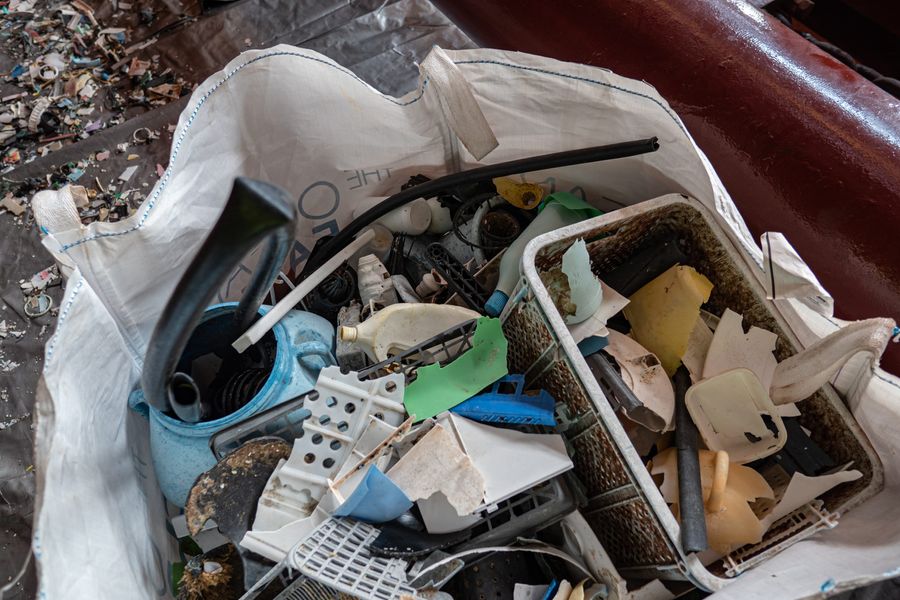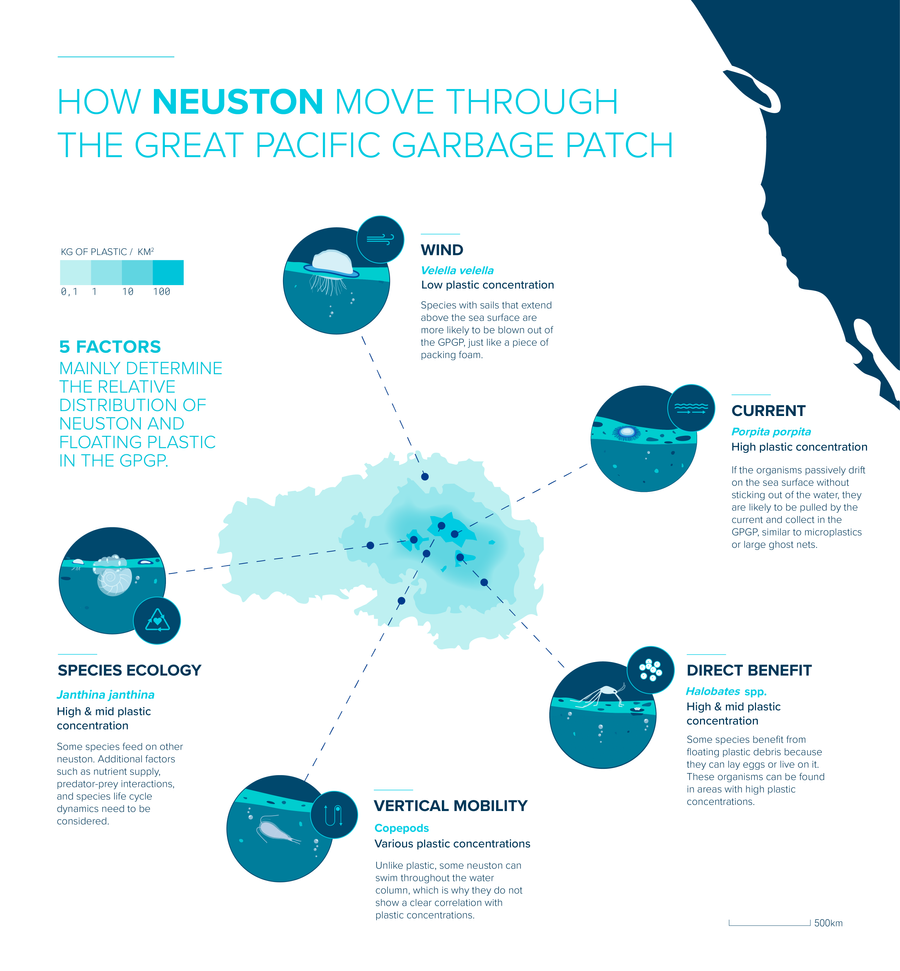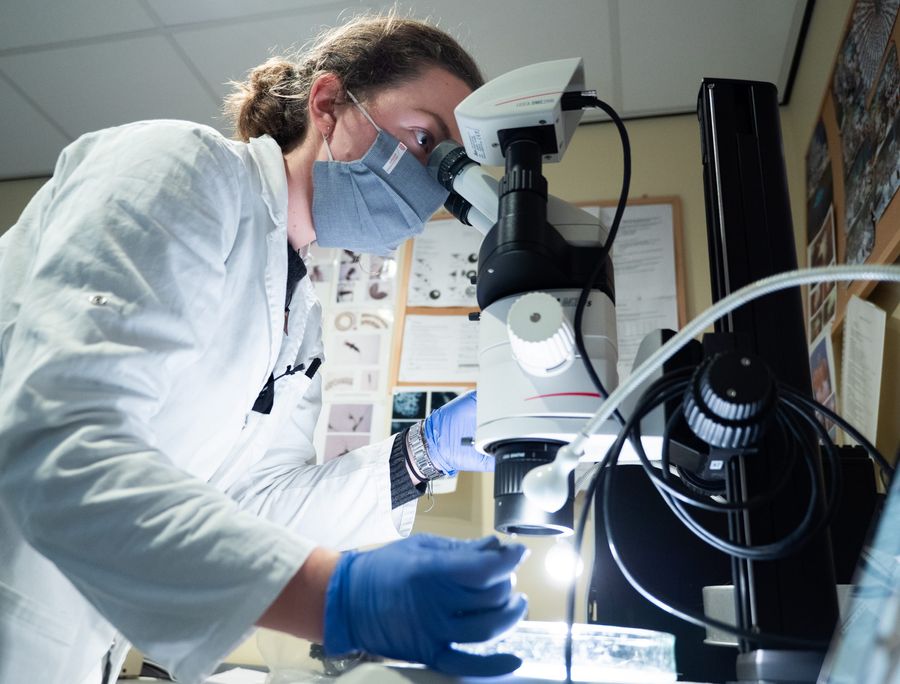
Neuston in the Great Pacific Garbage Patch and the Impact of Cleanup
Back to updates- Today, in Frontiers in Marine Science, The Ocean Cleanup published findings on the observed correlations between floating plastic and neuston in the Great Pacific Garbage Patch (GPGP).
- The relative distribution of neuston and floating plastic varies per species and is largely influenced by five factors: wind, currents, encounters with floating plastic objects, the organism’s ability to swim, and on the species ecology.
- Our observations reveal somewhat higher plastic-to-organism ratios inside the GPGP for many neustonic species compared to waters outside the GPGP, indicating that neuston inside the GPGP have more opportunities to interact with floating plastic debris.
- This new study points to a nonlinear relationship between plastic and neuston concentrations. It also provides a first observational baseline to develop ecological models that can help evaluate the long-term impacts of plastic pollution and offshore cleanup activities for neuston in the GPGP.
Plastic in our oceans has clear detriments to the ecosystems inhabiting them; nearly 700 marine species are reported to have encountered plastic debris, which can lead to entanglement, ingestion, or death. Protecting marine life from further harm caused by plastic pollution is the main driver behind our mission to rid the oceans of plastic. At the same time, we need to ensure that our cleanup operations have minimal negative side effects on marine ecosystems. This is why we not only closely monitor and study the interactions between our technology and the environment, but also invest in fundamental research to better understand the ecosystems we are determined to protect.
In our latest study published today in Frontiers of Marine Science, we provide rare observational data on the possible correlations between the distribution of plastic floating in the Great Pacific Garbage Patch and neuston, a collective of species living at the sea surface that ranges from jellyfish-like drifters to sea snails. This new research allows us to better evaluate which neustonic species might be affected by our cleanup operations in the Great Pacific Garbage Patch (GPGP) and to optimize our approach accordingly before we return with System 002.
WHY STUDY NEUSTON?
Our previous research has shown that the amount of plastic debris floating in the GPGP is rapidly increasing. Such increasing levels of plastic pollution pose a long-term risk for marine life present in these offshore waters. Therefore, removing plastic debris afloat in the GPGP will reduce the chances of harm caused by this pollution. It would also prevent the formation of vast amounts of secondary microplastics and their potential fallout into the deep sea, making its removal increasingly more difficult or even impossible.
Mitigating the adverse effects of plastic pollution through our cleanup efforts has raised some concerns, though, due to possible neuston bycatch during plastic removal ; one theory postulates that removing 90% of plastic from the ocean surface would remove 90% of the oceanic neuston, and that this is especially worrying as there is very little data available on this ecosystem. This assumes a lifecycle of low reproduction and long lifespans; something which appears unlikely, considering neuston organisms frequently end up on beaches in large numbers. Another key assumption of this statement is that plastic and neuston co-occur in the exact same spots and, therefore, the removal of plastic results in the direct removal of neuston. However, our newly published study highlights that the relationship between plastic accumulation and neuston abundance is more complicated than this.
CORRELATIONS BETWEEN FLOATING PLASTIC AND NEUSTON
Between August 2015 and December 2019, The Ocean Cleanup conducted several reconnaissance missions and cleanup trials in the GPGP. During these campaigns, onboard scientists collected data on the organic and inorganic makeup of the GPGP. By analyzing these findings, our scientists found that the relative distribution of neuston and floating plastic varies per species and is largely influenced by five factors: wind, currents, encounters with floating plastic objects, the organism’s ability to swim, and on the species ecology. The latter includes nutrient supply, prey and predator abundances, as well as species life cycle dynamics.
The primary neustonic species likely to be found in higher concentrations with floating plastic in the GPGP were those carried by the same forces as the plastic (i.e., currents) or that are benefitting from the presence of these floating objects (e.g., for laying eggs or for habitat). Examples of these neuston are Porpita porpita, Halobates spp., pteropods, isopods, heteropods, and crabs.
In contrast, due to their upright chitin sail that protrudes above the sea surface, species such as Velella velella (known as by-the-wind sailors), or Physalia physalis (Portuguese man o’ wars), were observed less frequently with high plastic concentrations in the GPGP. Much like the sail of a boat, the sails of these neuston affect their movement through the water; thus, in the same way that plastic debris with greater atmospheric drag are transported through the water, such as packing foam or highly buoyant objects like boats and large buoys, these organisms are more likely to be blown in and out of the GPGP.
Our scientists further observed that the more mobile neuston, such as zooplankton, fish, squid, euphausiids, and shrimps, can be found in both low and high concentrations of floating plastics. Essentially, these species are actively propelled through the water by biological mechanisms, such as active swimming and vertical migration within the water column, whereas positively buoyant plastics at the sea surface move passively.
Another important finding of our research is that many of the neustonic species present inside the GPGP, such as Halobates spp., Janthina janthina, Glaucus spp., copepods, amphipods, and fish, are also present in similar abundances in the subtropical waters bordering the GPGP. This observation indicates a possible recolonization potential of these organisms inside the GPGP from the surrounding waters which should be assessed in more detail with ecological models and DNA.
Neuston that were only observed inside the GPGP, such as Porpita porpita, pteropods, isopods, and heteropods, could have a higher vulnerability to our cleanup efforts in the GPGP. We are closely monitoring and assessing any neuston bycatch with a team of in-house and independent environmental scientists.
WHAT THIS MEANS FOR CLEANUP
Our findings indicate that there is not a direct parallel between plastic removal and neuston bycatch, and, therefore, removing 90% of floating plastic debris is unlikely to equate to a 90% reduction in neuston. More observational data of neustonic community structures, such as individual species, lifecycles, or seasonal variations in neuston composition, is needed to improve our understanding of this subject. The upcoming offshore campaign with System 002 provides an unprecedented opportunity to collect such missing data on this complex ecological system. Once processed, we can then share our findings with the wider scientific community and the public through peer-reviewed publications.
Aside from quantifying possible bycatch during plastic removal, ecological risk assessments of the impact of offshore cleanup activities on neuston and associated marine food chains must also consider the potential benefits of reducing the threats of plastic pollution. Our offshore operations are an ideal platform to conduct further research on organism distribution, levels of plastic ingestion, nutritional state, and chemical contamination of neustonic organisms. Such knowledge will allow us to evaluate the extent to which neuston inside the GPGP are affected by the high concentrations of floating plastic debris. Knowing that there is still much unknown, our scientists will continue to actively contribute to an improved understanding of the GPGP’s neuston ecosystem and how we maximize the ecological benefits of offshore cleanup activities.





